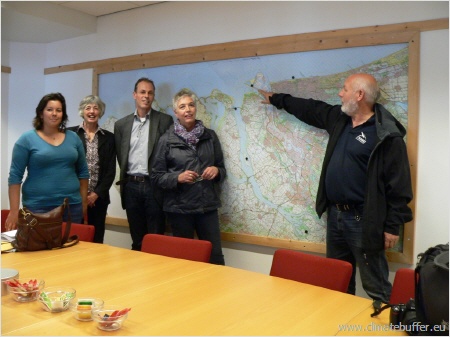Building with Nature
Participantsí reactions
“Thank goodness for the EU Habitats Directives which, although it has not protected land from development, in the face of massive economic pressure, has had some excellent results in providing a strong negotiating position for conservation bodies.” (Katherine Hearn, Staff member National Trust, United Kingdom)
“In such a complex environment it is an advantage to handle resulting conflicts with a mutual gains approach. Otherwise the risk of failing will increase dramatically.” (Alexander Porschke, President of NABU Hamburg, Germany)
“Although the core element of the study tour was of a strategic approach to management and strategic solutions, as a warden I still learned a good deal about practical solutions to land management at a site level, particularly at Voornes Duin and Tiengementen.” (Hugh Thurgate, Staff member National Trust, United Kingdom)
“We could test revegetation techniques like on Voornes Duin.” (Armandine Bichot, Luc Brun, Céline Damery, Conservation du Littoral, France).

Celine, Katherine, Roel, Eva and Ralf
(Photo: N.N., NABU)
Participants' Reactions
“The huge scale of investment for a relatively limited timescale (60 years) is interesting and impressive. Rather than a ‘little and often’-approach, it’s ‘big and often’.” (John Malley, Staff member National Trust, United Kingdom).
“The aspect of the Dutch approach to landscape and water management that had the biggest impact on me was their lack of concern about ‘interfering with natural processes’. This was refreshingly honest and pragmatic and has led to them being able to contemplate the massive engineering projects we were shown which allows them to safeguard industry, human population and nature in the most unlikely, to our eyes, situations and means.” (Angela Cott, Staff member National Trust, United Kingdom).
“Combining nature protection and the use for climate buffering with other motivations helps to overcome resistances against important projects, which give space to the river.” (Alexander Porschke, President of NABU Hamburg, Germany)
“Climate change is best tackled on a large scale, with effective collaborative working across all sectors (government, NGOs, private sector), strong policy support and sufficient funding. The importance of good dialogue and the ability to compromise were also highlighted as significant factors in developing and implementing unified approaches to climate change adaptation.” (Jamie Roberts, UK strategic Advisor, St. Helena National Trust, Saint Helena)
Participants' Reactions
“Once more it became clear that public relations and environmental education is of primary importance. That means it is necessary to achieve public awareness for the close connection between conservation and climate protection on a wider scale and under the use of different media. In the visitor center of Biesbosch this message is conveyed in a high substantive, aesthetic and didactical level.” (Ralf Schulte, Eva Jürgens, Dr. Marianne Ludewig, NABU, Germany)
“I am greatly impressed by the whole philosophy of water-awareness of Natuurmonumenten, all agencies, and people. Water is on your agenda in a way it is not in the UK- where water comes from, water quality, and flooding. We would be delighted if it had such a high profile in the UK.” (John Malley, Staff member National Trust, United Kingdom)
“From a more immediate perspective I was influenced by the creative and daring approach to flooding farmland on a relatively large scale. This was no “tinkering” and reinforce the concept of the necessity of scale to make a difference for biodiversity.” (David Thompson, Staff member National Trust, United Kingdom)
The project started in 2010 and was finished in 2012.